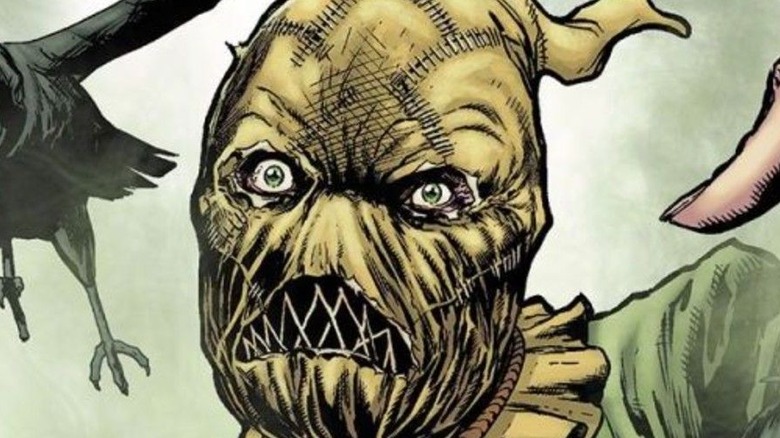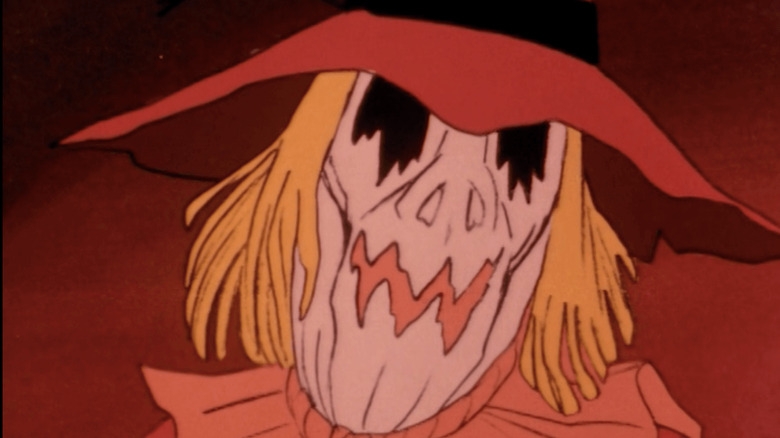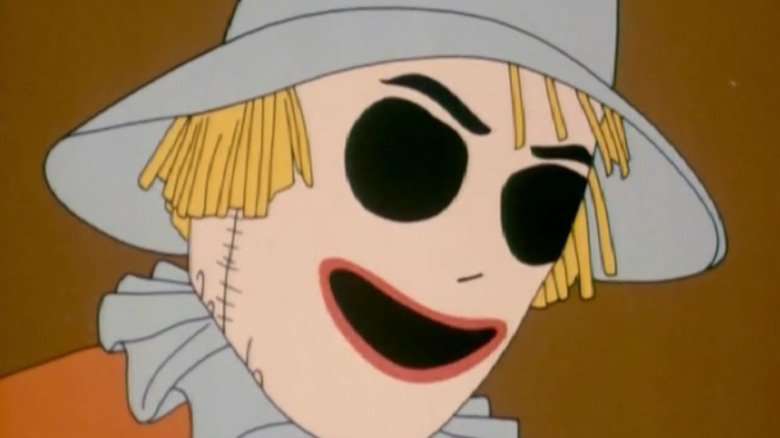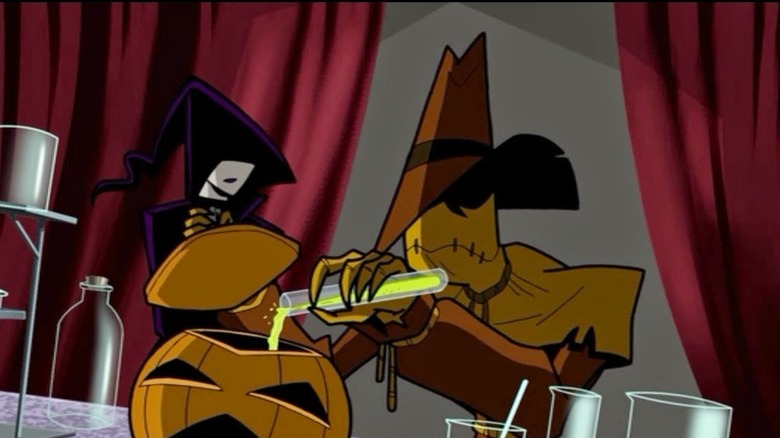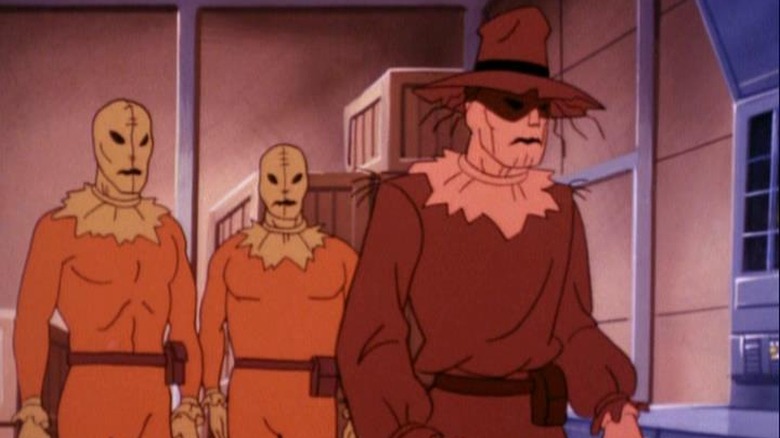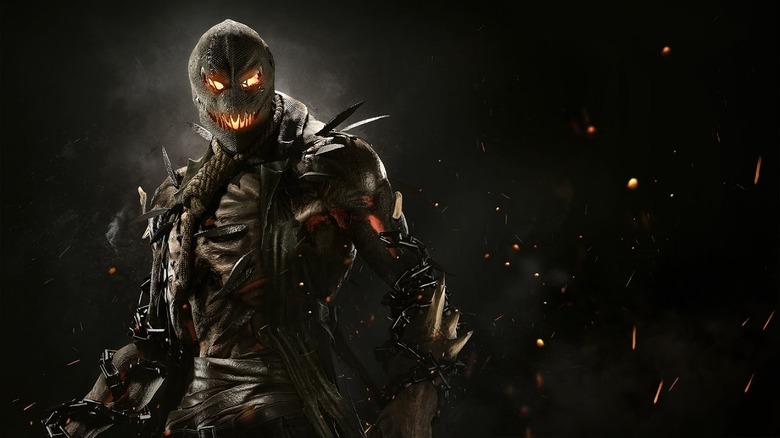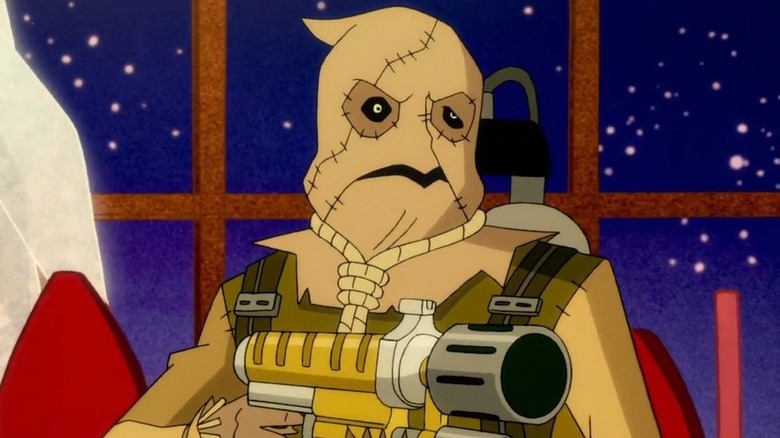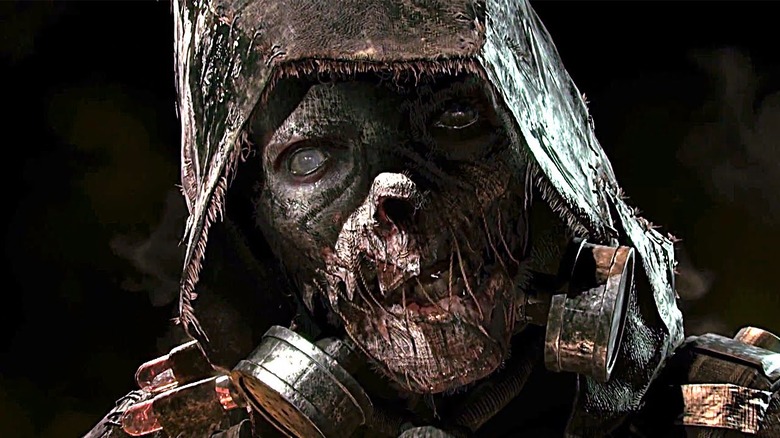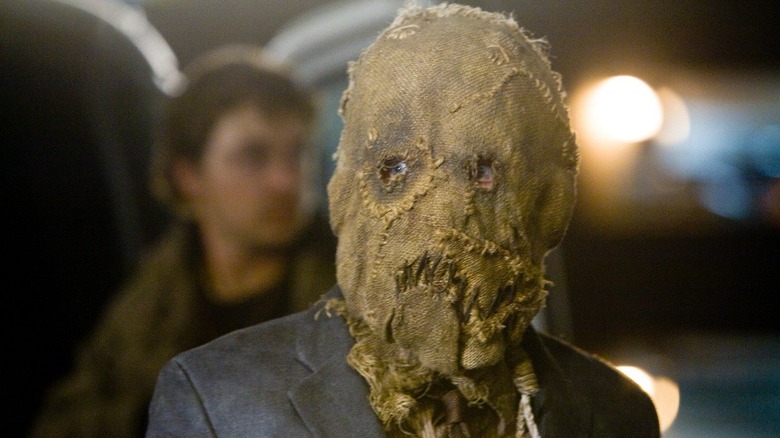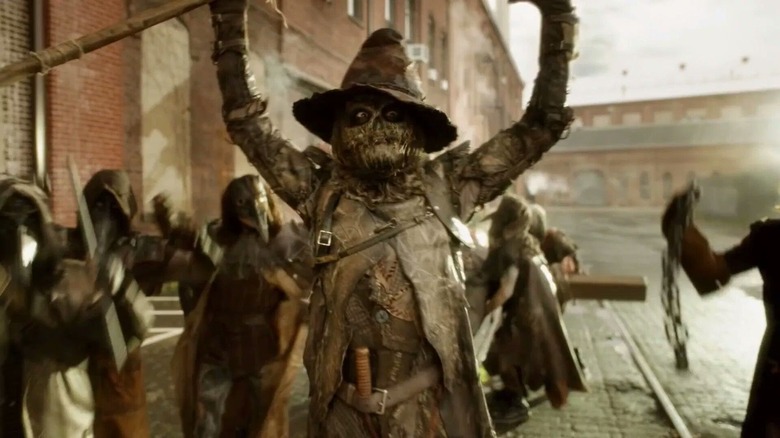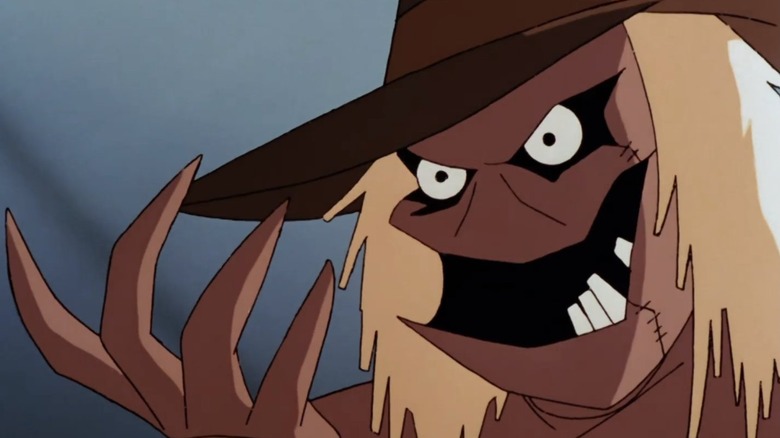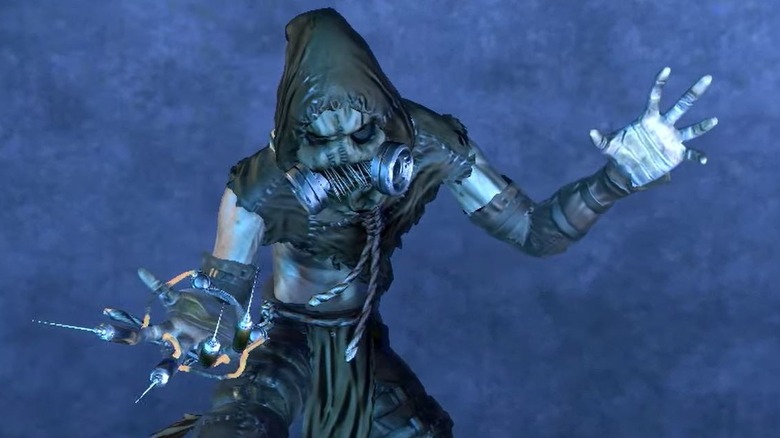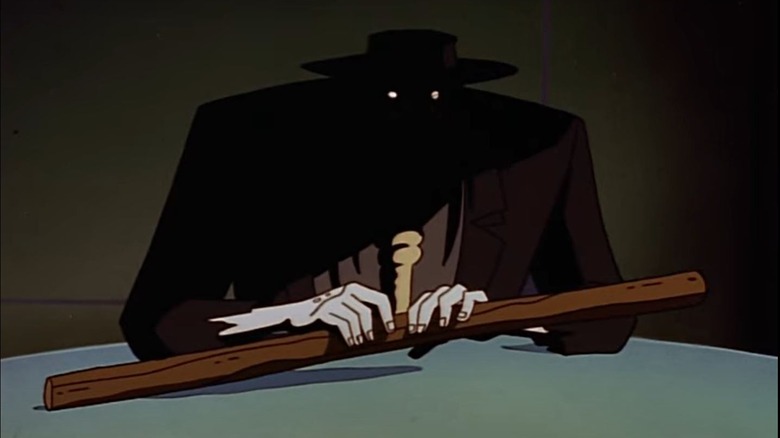Every Significant On-Screen Version Of DC's Scarecrow Ranked Worst To Best
Batman has perhaps the greatest villain gallery of any superhero ever, and the Scarecrow is one of the most effective antagonists in the set.
Bullied his entire life, deranged psychology professor Dr. Jonathan Crane decided to take Batman's most effective tool — fear — and become its absolute master. Donning the guise of the Scarecrow, Crane developed a series of "fear toxins" and unleashed them upon Gotham City, determined to make sure everybody suffer as intently from fear as he had.
As one of Batman's most popular villains, the Scarecrow has made countless appearances across the Caped Crusader's copious animated and live-action adaptations. Unfortunately, many of these appearances have been far from perfect, so we've ranked them here from worst to best.
Note: Since the high majority of Scarecrow's on-screen appearances have been brief cameos, we've limited ourselves to stories where the character held recurring, significant, or starring roles in the story.
Don Messick on "Challenge of the Super Friends"
Voiced by Scooby-Doo himself, Don Messick used his familiar tones to bring Scarecrow to life for all sixteen episodes of ABC's "Challenge of the Super Friends" in 1978. Unlike his time as the canine detective, however, this version of the supervillain would not be long-lived nor fondly remembered.
A children's show produced by the famed Hanna-Barbera Productions, "Super Friends" has since become infamous for creating some of the most ridiculous versions to date of its vast cast of characters. The show wasn't allowed to depict anything too serious or frightening, and with this in mind, it's rather easy to see why their version of the Scarecrow didn't exactly keep kids up at night.
One of the thirteen members of the Legion of Doom, Scarecrow never played a starring role in the show and, despite his stellar design, was relegated to a supporting role for all sixteen episodes. The villain wasn't even allowed to use his traditional fear gas, instead relying on various gadgets and a seemingly new, ill-conceived power where he could literally control crows. All-in-all, the villain was poorly served by the series and lost among its vast sea of characters.
Ted Knight on "The Batman/Superman Hour"
Scarecrow first appeared on-screen in 1968 in "The Batman/Superman Hour" (also known as "The Adventures of Batman"). He was voiced by the legendary Ted Knight ("Caddyshack"), who also provided the voices for Police Commissioner Jim Gordon, the Penguin, and Mister Freeze. This Scarecrow was rather silly throughout, but he did actually receive a starring role during his sole appearance in the second part of Season 1's ninth episode, "The Great Scarecrow Scare."
Unfortunately, his feature role was just about the only thing Ted Knight's turn as the villain had going for it. Scarecrow still never get to use his fear toxin and instead had to rely on a knock-out gas. Additionally, his entire plan in the episode was to simply commit random, petty thefts, and he consistently defeated himself throughout the story. He began by impersonating Jim Gordon at a Halloween party in order to steal a painting, but announced his identity anyway immediately before stealing it.
Next, Scarecrow decided he wanted to rob a ... farmer's market? This high-value target managed to survive the villain, however, because he kept imprisoning Batman, Robin, and Batgirl inside tool sheds (filled with everything the trio needed to escape) while only capturing them in the first place because Batgirl accidentally knocked over a basket of his sleeping-gas bombs. The villain and his voice actor might be legendary in retrospect, but this appearance most certainly wasn't.
Dee Bradley Baker on "Batman: The Brave and the Bold"
In 2008, Cartoon Network premiered "Batman: The Brave and the Bold," a new animated television series that had Batman team up with a different DC Superhero every episode. The show's episodes usually began with a short, unrelated adventure that had Batman team up with a lesser-known character before its title sequence, and Scarecrow starred in the cold open of the fifteenth episode of the show's premiere season.
Voiced by the prolific Dee Bradley Baker, the story saw the original Flash, Jay Garrick, team up with Batman in order to defeat Scarecrow and the Scream Queen. After the villainous duo infected every Halloween pumpkin with fear gas and set them to release the toxin once they've been lit as Jack-o'-lanterns, Batman saved the day while Flash scooped up every pumpkin in Gotham City.
Well, at least he was finally able to use his fear toxin. This version of Scarecrow was voiced, designed, and executed extremely well. His story, though short, was incredibly charming — but its brevity keeps it from placing any higher on this list.
Andre Stojka on "Super Powers Team: Galactic Guardians"
In 1985, Hanna-Barbera Productions decided to rebrand the "Super Friends" cartoon as "The Super Powers Team: Galactic Guardians." The "new" show updated its designs and aesthetics and finally began telling more dramatic stories, granting the Scarecrow his first great on-screen appearance in the show's fourth episode, "The Fear."
Voiced by Andre Stojka, the Scarecrow's real name was presented as a carefully-guarded secret, allowing him to join Gotham's police department as psychologist Jonathon Crane and use its resources to lure Batman, Wonder Woman, and Robin into a trap at Crime Alley. Scarecrow then used his "fear transmitters" to force Batman to relive the death of his parents, presenting Batman's origin outside of the comics for the first time ever. Eventually, Batman overcame his fears, figured out the Scarecrow's secret identity, and helped police capture the villain once and for all.
With a decent voice, a comics-accurate design, and his first serious story outside of comic books, this Scarecrow was finally allowed to be the master of fear, and he used it to great impact in the story. Though the dated nature of its presentation, animation, and voice-acting keeps the episode from ranking any higher on our list, it is the first time the villain was depicted properly.
Robert Englund in "Injustice 2"
In 2017, the makers of "Mortal Kombat" released "Injustice 2," the long-awaited sequel to their hit 2013 fighting game "Injustice: Gods Among Us." Featuring characters from across the DC Comics Universe, "Injustice 2" added Scarecrow to its impressive roster and gave the villain one of the most impressive visual depictions he has ever received.
NetherRealm's Studios went to great lengths to make the villain as frightening as possible, casting Robert Englund of Freddy Krueger fame to voice the villain and using the character's fear toxin to shape his physical appearance. When Scarecrow initially shows up, he looks like some random scientist with a bag over his head, but after he releases his fear toxin, he transforms into the monstrous character that players fight both online and in the campaign.
Scarecrow is normally a purely psychological threat, but by depicting his fear gas in this way, the creators brilliantly turned the literal fight against the Scarecrow monster into a more traditional, abstract battle against his fear toxin. When players battle against "Scarecrow," they aren't actually fighting to defeat the villain, but to keep their sanity.
Despite the game's incredible realization of the villain, however, it barely featured Scarecrow in its actual story, primarily using him as an excuse to allow Joker to briefly return despite his death in the original. If Scarecrow had been a more important part of the plot, this version would have ranked far better.
Rahul Kohli on "Harley Quinn"
Scarecrow makes a number of appearances in the ongoing animated "Harley Quinn" television series. Voiced by Rahul Kohli, the character is once again a member of the Legion of Doom, and appears multiple times as Harley and her crew attempt to join the supervillain team. He gives them a tour of their headquarters in Season 1, Episode 9, "A Seat at the Table" and is largely used for comedic effect until the show's eleventh episode, "Harley Quinn Highway," where he plays a monumental role in defeating the Justice League.
Scarecrow kidnaps Poison Ivy and uses her natural pheromones and toxins to create a new and improved version of his fear gas that turns even the plants mad with fear, transforming trees across Gotham City into murderous monsters to distract the Justice League so the mystic Queen of Fables can send them to another dimension. With the League out of the way, the Joker betrays the Legion of Doom, captures Batman, and takes Gotham City for himself. Scarecrow attempts to join the Clown Prince of Crime, but the villain eventually murders Crane after he becomes bored.
Despite his compelling design, some skilled voice-acting, and the fact he is finally allowed to use his traditional fear toxin as a major contribution to the show's plot, Scarecrow is reduced to a mere minion of both the Joker and the Legion of Doom. Combined with his comedic rendering and his unceremonious death, this version of Scarecrow lands solidly in the middle.
John Noble in "Batman: Arkham Knight"
In 2015, Rocksteady Studios finally released "Batman: Arkham Knight," the long-awaited conclusion to their trilogy of Batman video games. Unlike the first two games, "Arkham Knight" was supposed to feature the Scarecrow as its primary antagonist, with the titular Arkham Knight acting as his main enforcer. Unfortunately for Jonathon Crane, however, this did not turn out to be the case.
Despite the incredible reception of the game's predecessors, "Arkham Knight" was plagued by an unfocused and bloated narrative that relegated Scarecrow, its primary villain, to a supporting role in favor of yet another battle between the Joker and Batman. Once again, Scarecrow's fear toxin was primarily used so the Joker could return despite his death in a previous game, allowing the clown to feature as a hallucination in Batman's mind throughout the story until the pair battle for control of Batman's body in the game's climax.
Though the game could not have been possible without him, Scarecrow is practically absent from the game and is never actually fought by either the player or Batman and is instead beaten during a cutscene by the Arkham Knight. Despite incredible voice acting from John Noble and a remarkably disturbing design, Scarecrow is once again merely a tool for another villain's plot, keeping the video game he was meant to be the star of out of the top five.
Cillian Murphy in the Dark Knight Trilogy
Coming in at number five is Cillian Murphy's disturbing portrayal of the villain in "Batman Begins," "The Dark Knight," and "The Dark Knight Rises." Directed by Christopher Nolan, the movie trilogy attempted to depict a realistic version of Batman that could exist in our world, and as a result, presented audiences with a Scarecrow that managed to terrify his viewers despite being a man in a suit with a cloth hood.
A psychologist at Arkham Asylum, this Jonathon Crane perfected his fear toxin by experimenting on the Asylum's inmates before releasing a special version of it into Gotham's water supply. Despite the fact that he used his toxin to great effect against Christian Bale's Batman, Scarecrow was once again revealed to be a mere cog in another villain's plot. This time, it was Liam Neeson's Ra's al Ghul, who wanted to purge the evil of Gotham City once and for all by completely destroying it.
Even the most beloved Batman movies ever released couldn't manage to feature Scarecrow without reducing the arch-villain to the role of a henchman, and it is this massive demerit that keeps Cillian Murphy's incredible portrayal so far from the top spot.
Charlie Tahan and David W. Thompson on "Gotham"
Fox's "Gotham" followed Jim Gordon in the years before Bruce Wayne became the Batman. In Season 1, Episode 14, "The Fearsome Dr. Crane," Jim Gordon and Harvey Bullock met the Scarecrow's father, Dr. Gerald Crane, who was harvesting his victim's adrenal glands to create fear toxin. When the detectives confronted him in the following episode, "The Scarecrow," he injected his son Jonathon Crane, played by Charlie Tahan, with the toxin before Gordon and Bullock gunned him down.
Jonathon then experienced hallucinations of his greatest fear — a scarecrow — for years until Jerome (the show's version of the Joker) and the Mad Hatter helped him escape Gotham Asylum, allowing Jonathon to finally become the Scarecrow properly in Season 4, Episode 16, "A Dark Knight: One of My Three Soups." When Tahan's commitment to "Ozark" grew too large, the villain was recast as David W. Thompson and never removed his hood again.
This version of Scarecrow was terrifying, emerging as one of the show's best antagonists. Brilliantly portrayed by both Tahan and Thompson, he had perhaps the best live-action costume that Scarecrow has ever worn. Despite all of this however, he was once again demoted to the status of "just one of the villains" when he joined Jerome's "Legion of Horribles" alongside many of the show's other antagonists. Though his beginning and rise were meteoric, his later appearances keep him from ranking any higher on the list.
Henry Polic II on "Batman: The Animated Series"
In late 1992, Warner Bros released the first episode of "Batman: The Animated Series." Though they had no way of knowing it, they'd started what many fans would come to consider the best adaptation of Batman in any medium (it has a 9.9 user score on Metacritic). Because of this, it shouldn't surprise anyone to see their version of Scarecrow so high on this list.
Voiced by Henry Polic II, this Scarecrow was introduced in Season 1, Episode 3, "Nothing to Fear," making him the third villain in the entire series.
This version of Jonathon Crane was a scientist who became a psychology professor in order to test his fear toxin on students. When the university fired him for it, he had vowed revenge and become the Scarecrow. His schemes against the university were foiled by Batman both in this episode and again in Season 1, Episode 24, "Fear of Victory." Scarecrow's final attack on the Dark Knight in the 28th episode, "Dreams in Darkness," trapped Batman in Arkham Asylum as an inmate after exposure to Crane's latest serum seemed to drive him insane.
This version of Scarecrow was finally the dangerous, terrifying schemer he was in the comics, and he was allowed to star as the main villain of several episodes. Though his initial design was lacking, he sported a comics-accurate redesign in every appearance after that.
Looking back now, this version has no major drawbacks — the only reason it is number 3 on the list is simply because the next two incarnations were so utterly brilliant.
Dino Andrade in "Batman: Arkham Asylum"
Voiced by Dino Andrade, 2009's "Batman: Arkham Asylum" has one of the villain's most terrifying appearances ever. When Batman is exposed to fear gas while going down an elevator, the game dramatically transforms from an action-adventure game into a dread-inducing horror game.
Batman's grasp on reality slips as the game starts messing with the player's surroundings. Thousands of cockroaches start crawling all around the players as the game funnels them into and traps them within the asylum's morgue. Unable to leave, they have to explore as their surroundings constantly change when their back is turned.
The storage units lining the walls shake, and their doors open and close at random as the corpses inside roll out of and into their containers. Voices whispering "leave" and "get out" grow louder until everything suddenly goes silent and three body bags appear in the middle of the room. Forced to open them, players find Batman's dead parents and their first look at the Scarecrow's incredible new costume.
This incredibly tense, horrific introduction is very nearly enough to propel this version of Scarecrow to the top spot, but his following appearances in the game prove to be a case of diminishing returns. Though the game attempts this type of horror later on, it's never done as effectively as in the morgue. Additionally, Scarecrow's "boss battles" are ultimately little more than Halloween-themed platforming events, and the character is once again just another part of the Joker's plot.
Jeffrey Combs on "The New Batman Adventures"
There could be no other choice. When Batman's animated series was revamped as "The New Batman Adventures" in 1997, every character received a visual makeover, and none was more effective than the Scarecrow's.
Gone was the "Wizard of Oz" style outfit, and in its place was a chilling, zombie-like man in a decrepit suit with a noose as a neck-tie. The visual is simple and stunning, and it perfectly represented the show's new direction for the character.
Now voiced by horror legend Jeffrey Combs, the Scarecrow was the lead villain in two of the first season's best stories: Episode 4, "Never Fear," and Episode 11, "Over the Edge." In the first, Batman was exposed to Scarecrow's latest fear toxin, but instead of making the hero experience his greatest fears, it completely removed his ability to feel fear at all, turning Batman into a darker and more brutal version of himself who must eventually be stopped by Robin until he was cured. Then, in "Over the Edge," exposure to Scarecrow's traditional fear toxin plunged Barbara Gordon (aka Batgirl) into a nightmare hallucination where Jim Gordon and the Gotham City Police Department were hunting Batman down after discovering his secret identity because of her death.
Though he only appeared a handful of times, the show depicted the villain perfectly, creating a haunting visage with a chilling voice that stayed with viewers long after the show had concluded, making him the definitive version to beat.
